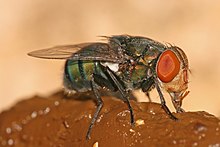
Back Koprophagie ALS أكل البراز Arabic Капрафагія Byelorussian Копрофагия Bulgarian Kaoc'hdebrerezh Breton Coprofàgia Catalan Koprofágie Czech Koprofagi Danish Koprophagie German Κοπροφαγία Greek

Coprophagia (/ˌkɒprəˈfeɪdʒiə/ KOP-rə-FAY-jee-ə)[1] or coprophagy (/kəˈprɒfədʒi/ kə-PROF-ə-jee) is the consumption of feces. The word is derived from the Ancient Greek κόπρος kópros "feces" and φαγεῖν phageîn "to eat". Coprophagy refers to many kinds of feces-eating, including eating feces of other species (heterospecifics), of other individuals (allocoprophagy), or one's own (autocoprophagy) – those once deposited or taken directly from the anus.[2]
In humans, coprophagia has been described since the late 19th century in individuals with mental illnesses and in some sexual acts,[3] such as the practices of anilingus and felching where sex partners insert their tongue into each other's anus and ingest biologically significant amounts of feces.[4] Some animal species eat feces as a normal behavior, in particular lagomorphs, which do so to allow tough plant materials to be digested more thoroughly by passing twice through the digestive tract. Other species may eat feces under certain conditions.
- ^ "Coprophagia". Dictionary.com. Archived from the original on 4 March 2016. Retrieved 2 September 2012.
- ^ Hirakawa H (2001). "Coprophagy in leporids and other mammalian herbivores". Mammal Review. 31 (1): 61–80. doi:10.1046/j.1365-2907.2001.00079.x.
- ^ Moore AM (2018). "Coprophagy in nineteenth-century psychiatry". Microbial Ecology in Health and Disease. 29 (1): 1535737. doi:10.1080/16512235.2018.1535737. PMC 6225515. PMID 30425610.
- ^ Malbon A (2021-02-12). "What is rimming? How to give a rim job safely". Netdoctor. Archived from the original on 2022-06-21. Retrieved 2022-06-21.
© MMXXIII Rich X Search. We shall prevail. All rights reserved. Rich X Search